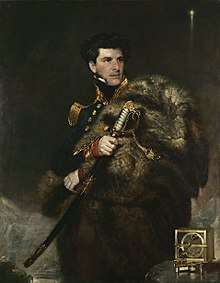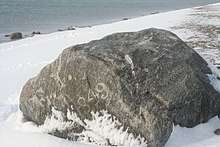James Clark Ross
| Sir James Clark Ross | |
|---|---|
 Portrait of Sir James Clark Ross by John R. Wildman. The object in the bottom righthand corner is a dip circle. | |
| Born |
15 April 1800 London, England |
| Died |
3 April 1862 (aged 61) Aston Abbotts, Buckinghamshire, England |
| Residence | Aylesbury, Buckinghamshire, England |
| Nationality | British |
| Known for | Antarctic exploration |
Sir James Clark Ross (15 April 1800 – 3 April 1862) was a British naval officer and explorer remembered today for his exploration of the Arctic with his uncle Sir John Ross and Sir William Parry and, in particular, his own expedition to Antarctica.
Arctic explorer
Ross was born in London, the nephew of Sir John Ross, under whom he entered the navy in 1812, accompanying him on Sir John's first Arctic voyage in search of a Northwest Passage in 1818. Between 1819 and 1827, Ross took part in four Arctic expeditions under Sir William Parry, and in 1829 to 1833, again served under his uncle on Sir John's second Arctic voyage. It was during this trip that a small party led by James Ross (including Thomas Abernethy) located the position of the North Magnetic Pole on 1 June 1831 on the Boothia Peninsula in the far north of Canada. It was on this trip, too, that Ross charted the Beaufort Islands, later renamed Clarence Islands by his uncle.[1][2]
In 1834, Ross was promoted to Captain. In December 1835, he offered his services to the Admiralty to resupply 11 whaling ships which had become trapped in Baffin Bay. They accepted his offer, and he set sail in HMS Cove in January 1836. The crossing was difficult, and by the time he had reached the last known position of the whalers in June, all but one had managed to return home. Ross found no trace of this last vessel, William Torr, which was probably crushed in the ice in December 1835.[3] He returned to Hull in September 1836 with all his crew in good health.
From 1835–1839, except for his voyage with Cove, he conducted a magnetic survey of Great Britain with Edward Sabine.
Antarctic explorer

Between 1839 and 1843, Ross commanded an Antarctic expedition comprising the vessels HMS Erebus and HMS Terror; he charted much of the coastline of the continent. Francis Crozier was second-in-command of the expedition, commanding HMS Terror. Support for the expedition had been arranged by Francis Beaufort, hydrographer of the Navy and a member of several scientific societies. On the expedition was Joseph Dalton Hooker, who had been invited along as assistant surgeon. Erebus and Terror were bomb vessels – an unusual type of warship named after the mortar bombs they were designed to fire and constructed with extremely strong hulls, to withstand the recoil of the mortars, which were to prove of great value in thick ice.[4][5]
In 1841, James Ross discovered the Ross Sea, Victoria Land, and the volcanoes Mount Erebus and Mount Terror, which were named for the expedition's vessels. They sailed for 250 nautical miles (460 km) along the edge of the low, flat-topped ice shelf they called variously the Barrier or the Great Ice Barrier, later named the Ross Ice Shelf in his honour. In the following year, he attempted to penetrate south at about 55°W, and explored the eastern side of what is now known as James Ross Island, discovering and naming Snow Hill Island and Seymour Island. Ross reported that Admiralty Sound (which he named Admiralty Inlet) appeared to him to have been blocked by glaciers at its southern end.[6] He was awarded the Gold Medal of the Société de Géographie in 1843, knighted in 1844, and elected to the Royal Society in 1848.[7]
Search for Franklin's lost expedition

In 1848, Ross was sent on one of three expeditions to find Sir John Franklin.[lower-alpha 1] He was given command of HMS Enterprise, accompanied by HMS Investigator,[8] Because of heavy ice in Baffin Bay he only reached the northeast tip of Somerset Island where he was frozen in at Port Leopold. In the spring he and Francis McClintock explored the west coast of the island by sledge. He recognized Peel Sound but thought it too ice-choked for Franklin to have used it. (In fact Franklin had used it in 1846 when the extent of sea ice had been atypically low.) The next summer he tried to reach Wellington Channel but was blocked by ice and returned to England.
Personal life
He was married to Lady Ann Ross. He died at Aylesbury in 1862, five years after his wife. A blue plaque marks Ross's home in Eliot Place, Blackheath, London.[9] His closest friend was Francis Crozier, with whom he sailed many times.
He also lived in the ancient House of the Abbots of St. Albans in Buckinghamshire. He is buried with his wife in the local churchyard of St. James the Great, Aston Abbotts. In the gardens of the Abbey there is a lake with two islands, named after the ships Terror and Erebus.[10]
Tributes
- The Ross seal, one of the four Antarctic phocids, first described during the Ross expedition[11]
- The James Ross Strait, Ross Bay, Ross Point, and Rossoya in the Arctic are all named after him.[12]
- RRS James Clark Ross is a British Antarctic Survey research ship.[13]
- The crater Ross on the Moon is named after him.[14]
- Ross's gull, a small gull, the only species in its genus, that breeds in the high arctic of northernmost North America and northeast Siberia[15]
- Ross Dependency, Ross Island, Ross Ice Shelf[16] and Ross Sea in the Antarctic are all named after him.[12]
See also
Notes
- ↑ The others were the Rae–Richardson Arctic Expedition and the expedition aboard HMS Plover and HMS Herald through the Bering Strait.
References
- ↑ Bossi, Maurizio; Vieusseux, G.P. (1984). Notizie di viaggi lontani : l'esplorazione extraeuropea nei periodici del primo Ottocento, 1815–1845. Naples: Guida. ISBN 88-7042-399-9.
- ↑ Woodman, David C. (1991). Unravelling the Franklin disaster : Inuit testimony. McGill-Queen's University Press.
- ↑ Jones, A. G. E. (1950). "The Voyage of H.M.S. Cove, Captain James Clark Ross, 1835–36". Polar Record. 5 (40): 543–556. doi:10.1017/S0032247400045150. Retrieved 21 April 2012.
- ↑ "James Clark Ross (1800-1862)". Glasgow Digital Library. Retrieved 26 February 2016.
- ↑ Ward, P. (2001). "Antarctic expedition, 1839–1843, James Clark Ross".
- ↑ Ross, James Ross (1847). A Voyage of Discovery and Research in the Southern and Antarctic Regions, During the Years 1839–43. 2. London: John Murray.
- ↑ Appletons' annual cyclopaedia and register of important events of the year: 1862. New York: D. Appleton & Company. 1863. p. 749.
- ↑ Mowat, Farley (1973). Ordeal by ice; the search for the Northwest Passage (The Vanished Ships)
|format=requires|url=(help). Toronto: McClelland and Stewart Ltd. p. 250. OCLC 1391959. - ↑ "Sir James Clark Ross 1800-1862 polar explorer lived here". Open Plaques. Retrieved 28 October 2016.
- ↑ "History - Sir James Clark Ross". Aston Abbotts. Retrieved 28 October 2016.
- ↑ Riffenburgh, Beau (2007). Encyclopedia of the Antarctic. Taylor & Francis. p. 815. ISBN 978-0-415-97024-2.
- 1 2 Ross, Maurice James (1994). Polar Pioneers: John Ross and James Clark Ross. McGill-Queen's Press. ISBN 978-0-7735-1234-4.
- ↑ "RRS James Clark Ross". British Antarctic Survey. Retrieved 28 October 2016.
- ↑ "North Magnetic Pole Discovered 1 June 1831". History Channel. Retrieved 21 April 2017.
- ↑ Rushton, Annabel (9 February 2014). "Who's this Ross character then?". RSPB. Retrieved 28 October 2016.
- ↑ 1) [Bertrand, Kenneth John, et al, ed.] The Geographical Names of Antarctica. Special Publication No. 86. Washington, D.C.: U.S. Board on Geographical Names, May 1947. 2) [Bertrand, Kenneth J. and Fred G. Alberts]. Gazetteer No. 14. Geographic Names of Antarctica. Washington: US Government Printing Office, January 1956.
Bibliography
External links
| Wikisource has original text related to this article: |
- Works by or about James Clark Ross at Internet Archive

| Wikimedia Commons has media related to James Clark Ross. |
.svg.png)